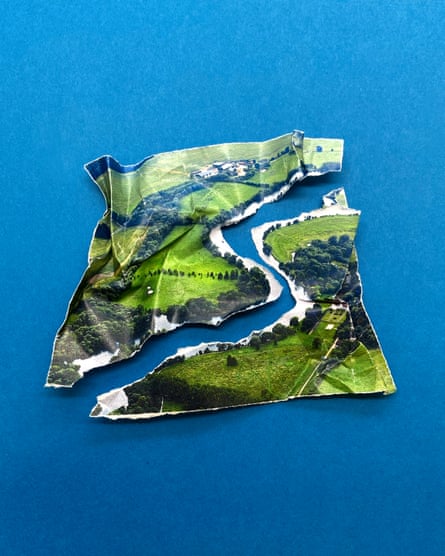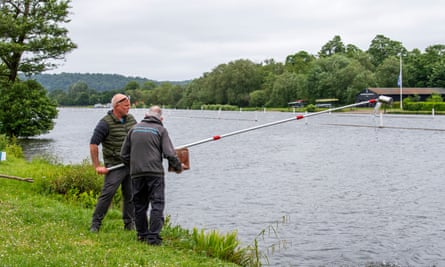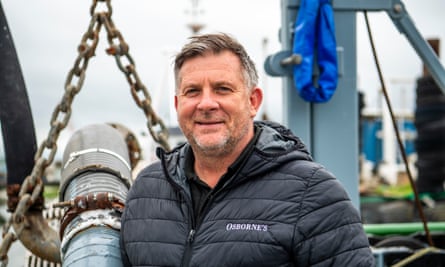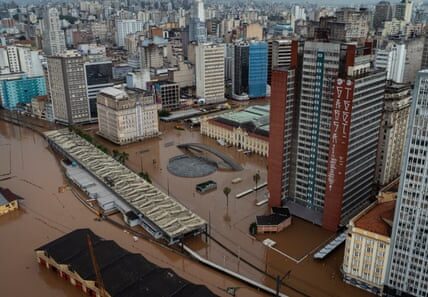
Red kites swoop above Fawley Meadows as Dave Wallace dips a sampling beaker into the deep green water of the River Thames on a late spring day. A sharp wind blows droplets upstream towards the arches of Henley Bridge, while the might of the river, its path here straight and wide, pulls downstream towards Windsor, on its 215-mile odyssey to the North Sea.
Today, the water meadows along its banks host blue and white striped marquees, lined up in uniform rows for the Henley regatta. After the rowers depart, the river bears the swimmers who follow. They dip, jump and dive its depths at an annual festival of open water races, echoing the galas that took place in Victorian days.
Wallace used to join those taking to the river to swim – but dark currents beneath the waters have persuaded him to remain on the banks.
“I only began to realise what was being done to our river when I was swimming the last section of the Henley to Marlow marathon two years ago,” Wallace says. “It was a really dry summer, there was barely any flow in the river, the water was flat, and I was in the water for a long time. As I swam down to the outskirts of Marlow, I could see brown stuff in the water. I realised I was swimming in crap. It was really nasty stuff.”

Shocked by his awakening, Wallace abandoned his swimming hobby to investigate, instead, the impact on the river of a toxic cocktail of pollution from treated and untreated sewage, amid growing evidence it is affecting biodiversity and presenting a threat to public health. He has since uncovered details of all the sewage outflows going into the Thames at Henley, set up regular monitoring of the waters to generate data as evidence, and become a committed river activist.
Wallace is not alone. All along the course of the river – turning north, meandering south, passing through locks, historic landmarks, Richmond and Kew, swelling beneath the House of Commons with the turning tide, and on to Docklands and beyond – concern for the health of the Thames has led many other ordinary people, who live, work or play on the water, to take up the fight for the health of the river.
The last 15 years of decline in rivers suggests they have much to do. In 2009, a year before the Conservatives first took power in a coalition with the Liberal Democrats, a quarter of English rivers were judged as being of good ecological standard, a marker which examines the flow, habitat and biological quality; by 2022 not one river was in a healthy state.
As politicians take to the doorsteps of towns and villages along the Thames’s journey the question of sewage pollution has become one of the top five issues of concern. Clean water is mentioned in every party manifesto. Along the river’s route in Liberal Democrat target marginals such as Esher in Surrey and the Oxfordshire constituencies of Henley and Witney, where David Cameron was once MP, concerns over sewage pollution could be a swing factor to unseat the Tories.
To trace the decline of the Thames is to tell a story shared by almost every river across the country, more than 30 years after a Conservative government privatised the water industry – creating a sector which, the evidence suggests, has prioritised shareholder dividends over investment in clean water, the environment and public health. For voters, including many in Tory heartlands, the polluting of Britain’s rivers is among the most egregious legacies of 14 years of Conservative rule.
In the constituency of South Cotswolds, traditional Tory country, a modest pile of stones beneath an ancient ash tree at Trewsbury Mead near Kemble marks the source of the River Thames. The water that flows 215 miles to the sea is drawn from the limestone aquifers in the surrounding hills.
Reflecting on the ancient spiritual associations with the river, Chris Park, a druid and meadmaker, says the river at its start is something to be celebrated. “The water that comes out of the ground at these springs is pure, like a newborn baby. Everywhere in the world where we find water, prayers and offerings have been made, because without water there is no life, and I think we have lost sight of that.”
A statue of the river’s deity, Old Father Thames, reposing as he points down to the plenty and bounty beneath him, sat here at Thames Head before an act of vandalism in 1974 resulted in him being moved further down the river. That vandalism is echoed, many say, in the destruction of the river today.
As the river’s springs wind down from their source 110 metres above sea level, and the chalk stream headwaters, such as the Coln, Kennet, Evenlode and Windrush, feed its flow, the murky truth of the modern treatment of the Thames begins.
At Fairford, 4 miles from the source, the once pristine River Coln has been subjected to relentless sewage discharges into its burbling limestone waters from the storm overflow at a Thames Water sewage works. In January and February raw sewage poured into the Coln for 44 days, with spills continuing long after heavy rainfall, as the groundwater ingressed into a pipe network left crumbling from a lack of infrastructure investment.
“These are the headwaters of the Thames. This is literally where it all starts, here in the Cotswolds and yet this is what is happening,” Andrew Doherty, a local resident and Liberal Democrat district councillor, tells me. “This is not something that should be happening in the third decade of the 21st century.”
A little further down the Thames, where a 13th-century bridge over the river at Newbridge looks down at its confluence with the River Windrush, I meet Ash Smith, a retired detective. The smaller river is distinct as a cloudy, dim and concrete grey stream joining the wider flow.
“I used to come and fish here as a boy; it was pristine, clear then, you could see streams of ranunculus weeds and the gravel bottom.” Decades later when he retired, Smith moved to live on the Windrush near Witney, drawn by memories of a magnificent pristine river.
“The first thing to strike me, that first spring by the river, was one lonely looking clump of flowering ranunculus streamer weed where there should have been many,” he says. “Now the water has just become steadily murkier for more of the time and the gravel, once quite clean, became coated in grey and black deposits so that now it is really hard to see any fish at all and the life-giving weed has all gone.”
Smith has built a body of evidence of the pollution of the Thames and its tributaries, working with his neighbour Peter Hammond, a retired professor who specialised in machine learning. Using environmental information requests, and freedom of information laws, Smith and his team of volunteers were among the first to expose the routine dumping of raw sewage into rivers by Thames Water and other privatised water companies all over England.
While spills of raw sewage are allowed under exceptional circumstances, such as extreme rainfall, Hammond presented a paper to MPs that suggested the scale of illegal sewage dumping was 10 times more than the Environment Agency believed. His work was the catalyst for a criminal investigation into illegal sewage discharges from more than 2,000 water company treatment plants.
Insights into the amount of raw sewage Thames Water discharges into the river emerge in dry data gathered by water companies and released each year by the Environment Agency. In Greater London alone, between April 2023 and March 2024 Thames Water released raw sewage into the Thames and its tributaries for 12,105 hours, a fourfold increase on the year before, according to figures collated by the mayor of London’s office.
A brief glimpse at what kind of scale we are talking about can be garnered by examining a vast treatment works in west London, behind Twickenham rugby stadium – the only Thames Water treatment works to publish volumes. In 2020 the works released 3.5bn litres of raw sewage into the river, equivalent to 1,400 Olympic pools, and a 600% increase on 2015 (pdf).
Untreated effluent is not the only concern, however. Every day, treated sewage, the waste of the millions populating the river’s route, pours into the waters from Thames Water treatment works. Despite our 21st-century advancements, the solution to wastewater management is still to dump it in the river, with devastating effects.
“All sewage, treated and untreated, kills rivers by flooding them with nutrients, which leads to an increase in algae, which in turn exhausts the oxygen and blocks out the light, thus suffocating fish, insects and plants,” says Smith.
Concerns today focus not only on the destruction of the biodiversity in the river; increasingly the levels of faecal organisms in freshwater are raising worries about human health.
“The treatment of sewage is fairly basic in the UK,” says James Wallace, the chief executive of River Action, a charity formed amid growing concerns about the state of UK rivers. “There is no requirement to remove pathogens [microorganisms that have the potential to cause infectious diseases], phosphates or microplastics, from the final treated effluent pouring into the river from sewage treatment works. We are told that it is clean water, but that is absolutely not true.
“There is no requirement for water companies or the EA to monitor bacteria like E coli and the disease-spreading risk of what is going into the water unless it’s associated with a handful of bathing water sites. So every day Thames Water, like all other water companies across the country, is allowing pathogens to discharge into the river without warning anyone of the significant risk of illness including life-threatening sepsis.
“This presents a totally unknown national hazard to human health.”
Treating the Thames as an open sewer is nothing new historically. For hundreds of years England’s most significant river has been a dumping ground for waste. But this history is marked by moments of clarity and action.
In the mid-19th century Charles Dickens remarked the waters had become “a deadly sewer … in the place of a fine, fresh river”. The stench was so great in the summer of 1858, MPs were forced to flee the House of Commons with their faces covered. Shortly after they pushed through a bill that led to the creation by Joseph Bazalgette of a modern sewerage system.
Today Bazalgette’s creation is still the basis of wastewater infrastructure, more than three decades after the Conservative prime minister, Margaret Thatcher, created a global anomaly by handing over a debt-free water monopoly to the private sector. Investors were given a guaranteed income, a captive audience, and an investment vehicle that has paid out £78bn in dividends since 1991, at the same time as loading debts on to the balance sheets of more than £60bn.
Thames Water is one of the most highly leveraged privatised water companies, struggling with debts of £14.7bn, as its investors pull their support, and seeking bill increases of more than 40%, as well as lower financial penalties for its river pollution, in an effort to stay afloat.
The debate on private ownership continues, but the evidence on pollution seems stark. Prof Chris Whitty, the chief medical officer for England, is now warning that minimising human faecal organisms entering rivers as a result of water company actions is a public health priority that requires a 21st-century solution.
For everyone who uses the Thames at close quarters, including swimmers, canoeists, paddle-boarders and rowers, the risk to health is becoming a growing concern.

On a bend in the river at Hammersmith – where twice a day the tidal reach transforms the river, emptying its waters to expose the muddy river bed, and refilling as the North Sea floods inland – coloured lycra-covered heads and orange tow-floats, bobbing in the swollen tide, are a familiar summer spectacle.
This spring, though, concerns about the impact of sewage discharges from Thames Water treatment works persuaded the organisers of a series of tidal swims from the banks here to cancel the first three of the season.
Nearby the captain of the Furnivall sculling club has watched as her rowers fall sick and get infected cuts and blisters from contact with the water. “You can actually see human excrement in the water, solid human waste. It has become a common occurrence,” says Evelyn Tichy.
“Older members, who are in their 60s and 70s, say they have never seen it so bad. I travel to Europe a lot to row and what I find shocking is the state of rivers here in comparison. In Europe the rivers are clean and safe for people to row.”
Further upstream at Molesey, across the river from Henry VIII’s lavish palace at Hampton Court, Helen Taylor, a rowing club coach, has also seen a noticeable increase in the level of sewage discharges. “Water quality has decreased quite a lot,” she says. “Obviously everyone is a lot more aware of water quality now, but we are seeing more people getting sick, or getting infected blisters and cuts on their hands from the contact with the water.”
Anecdotal evidence of the risk to human health is everywhere along the river’s path. Last summer along the stretch of river in Henley where Dave Wallace has been testing the water quality, Alex Wynn-Jones’s teenage son was enjoying an early summer’s day mucking about in the river. “It’s something all the kids round here like to do, it’s a small town and they all gather on the meadow together,” she says. “He came home and at 4am he was projectile vomiting. He was very ill, it lasted for three days he had stomach cramps and was in a lot of pain.”

The stories emerging have fuelled a growing fury directed towards Thames Water, the Conservative government and the regulators for failing to address the scale of the devastation to the river system. Colourful protests have sprung up along the Thames’s route, in Oxford, Teddington, Westminster, Southend and many other locations, as ordinary people become campaigners and activists calling for more care to be taken with their river.
“Does someone have to die for the government to make water companies put people before profit?” River Action’s James Wallace asks.
Amid the pastoral beauty of Pangbourne, where water meadows cradle the Thames, the writer Nick Hayes has chosen to live on a boat, absorbing the tranquillity enjoyed by Kenneth Grahame, the Wind in the Willows author and leading evangelist for messing about in boats.
From his vantage point, Hayes has noticed an explosion in the leisure use of the waters, from paddle-boarding to swimming and kayaking, and the resulting rush of concern about the river. “Cultural change in the people is usually the most noted way of creating change in Westminster,” says Hayes. “Today people from all walks of life care about the river, they have regained that sense of belonging with it, they feel connected and with that comes a feeling of civil responsibility and a desire to be its guardians, which is very exciting.
“This is about telling a different story, one that makes the current orthodoxy – an orthodoxy which has left the river visibly fucked – seem abhorrent.”
There is plenty of evidence from history that a change in orthodoxy can improve the water quality of the Thames, and the waterways across the whole of Britain.
At Old Leigh, on the north coast of the vast Thames estuary in Essex, where the mudflats at low tide spread out to the sea, the Osborne family has been fishing for shellfish for five generations, since 1890.
Today they run two cockle boats, which will gather about 12 tonnes a day when the season starts in mid-June. As veterans of this stretch of the Thames, they believe the estuary waters are less polluted by sewage than decades ago. “The water here is much cleaner than it used to be,” says Graham Osborne. “Thirty years ago you would see the Bovril boats steaming up the estuary bringing raw sewage from the city of London to dump into the water.
“But they stopped all that and now the grounds we fish are category A, the highest category, or category B.”

The journeys of the so-called Bovril boats – specially designed sewage vessels the task of which was to remove solid human waste from London and dump it in the estuary – only ended in 1998, after EU regulations to clean up waterways were adopted, bringing to an end a practice that had been the established policy for 111 years.
Back in Henley, Wallace has begun to test the river on a daily basis at the Henley Mile, the straight stretch where elite rowers will make their final pull to reach the finishing line at the town’s internationally renowned regatta in a few days’ time, in the hope he can be a small part of a systemic change.
“When I first got into this I had no idea what the water industry was doing. I had always assumed the rivers were getting cleaner. I was horrified,” he says.
Now nicknamed the Henley sewage sleuth, in the 18 months since his unpleasant marathon swim, he has gathered evidence to expose the cocktail of pollution entering the river in his town. Using freedom of information laws, Wallace obtained a previously unpublished Thames Water map and began to trace the sewage discharges from the treatment works entering the river via a series of partly hidden streams.
“This is sewage pouring into our river daily at the same time that recreational use here has soared,” he says. “The Henley Mile should be teeming with life with kids and people enjoying the river. But now we are in a situation where people are starting to say: ‘I am not sure that I want to do that.’”
E coli levels recorded by Wallace on his first day of testing were 2229cfu/100ml of water – anything above 900 is considered unsafe for bathing. “That is extremely high, and you wouldn’t want anyone even getting splashed by that river water,” he says.
He says his work is double-edged – revealing the pollution could make him a figure of hate, as leisure businesses relying on the Thames come into jeopardy – but he believes change will only come with transparency.
“The Thames is the most incredible river; the whole history of Britain is wrapped up in the history of these waters,” says Wallace. “But strangely for such a significant river, it does not have a voice. I wanted to help to give it that.”
Source: theguardian.com



